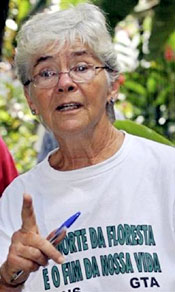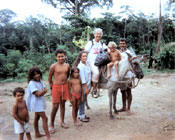Expanded Story of Sister Dorothy Stang
Sister Dorothy Stang decided early on that she would give her life to God as a Sister of Notre Dame de Namur. Her deepest desire was to serve the poor as a missionary and on her application she wrote, "I want to be a missionary in China."
But God's plan was not Dot's plan. After teaching in Chicago and Phoenix she was to serve in Brazil. She and four other Sisters went to Brazil in 1966 where she worked to help poor farmers build independent futures for their families until her murder in 2005.
The Fight Grows Dangerous
Over the years, the work became progressively more dangerous for the Sisters in Brazil and for the farmers and their families. As the world discovered the vast possibilities offered by the rich natural resources of the Amazon rain forest, people with more limited and self-centered goals began to plan ways to capitalize upon them. Gradually, loggers, ranchers, land speculators, and agribusiness became the dominant forces in the region, victimizing the poorer farmers and destroying the rain forest.
The Amazon rain forest is one of the largest remaining virgin forests on earth. Its original trees and vegetation comprise 40% of all the tropical rainforests in the world. The forest hosts 50% of the world's plant species and is home to 20 million people. In addition, 20% of the earth's fresh water reserve runs through the Amazon River basin.
Sister Dorothy understood that the rain forest, also called the earth's lungs, plays a critical role in the exchange of gases between the biosphere and the atmosphere. Her frustration grew as she witnessed the destruction of this natural resource so vital to her people's and the planet's future. She saw the forest and the people plundered for financial gain by illegal logging operations, land speculators, and cattle ranchers. She witnessed political leaders allowing the destruction to continue.
Named to a Death List
In spite of Sister Dorothy's good work for the people of Para and the world, protecting the rain forest by encouraging sustainable farming techniques presented a threat to loggers, land speculators, and agribusiness concerns in the region. As a result, in the late 90s she was named to a "death list" created by the power brokers of the area.
Hired killings of human rights advocates, environmentalists, and farmers account for one-third of the deaths in the region each year. The goal of these calculated murders is to eliminate opposition to the clear-cutting and burning of the forest so that fields of soy beans can be planted, trees can be logged, and cattle can graze. Another goal of the killings is to eliminate those who empower and educate the peasants; and finally the killings are meant to intimidate the farmers and keep them ensnared in an endless cycle of debt, akin to slavery. Sister Dorothy became a prime target.
Hired Guns Fired Six Shots
Sister Dorothy repeatedly asked the city, state and national government for protection for the people but she was always refused. Then on February 12, 2005, on a dirt road at the Boa Esperanca settlement in a rural area in Para, two hired gunmen fired six shots and killed Sister Dorothy. She was murdered because she had put into place programs that created self-sufficient communities of people committed to their own independence as well as to the sustenance of the rain forest.
As the gunmen approached Sister Dorothy, she took her Bible from her bag and began to read the Beatitudes: Blessed are those who hunger and thirst for justice...
Following Sister Dorothy's death, Brazilian President Luiz Inacio da Silva put nearly 20,000 of the Amazon's 1.6 million square miles under federal environmental protection. This land is located in the Anapu region that was Sister Dorothy's home. This action gives hope to human rights defenders and environmentalists, and it encourages the Sisters of Notre Dame de Namur and the people of the Anapu region to continue working in the tradition of their role model and compatriot, Sister Dorothy.
Her work is recognized around the world for its boldness, its beauty, and its consistency with the mission of the Sisters of Notre Dame de Namur to help and educate the poor. Dorothy your dream lives on in the struggle of the people.
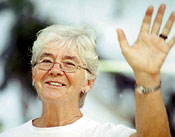
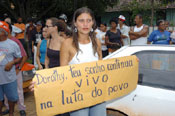
Dorothy your dream lives on in the struggle of the people
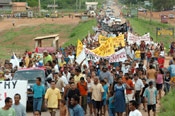
The funeral procession in Anapu
